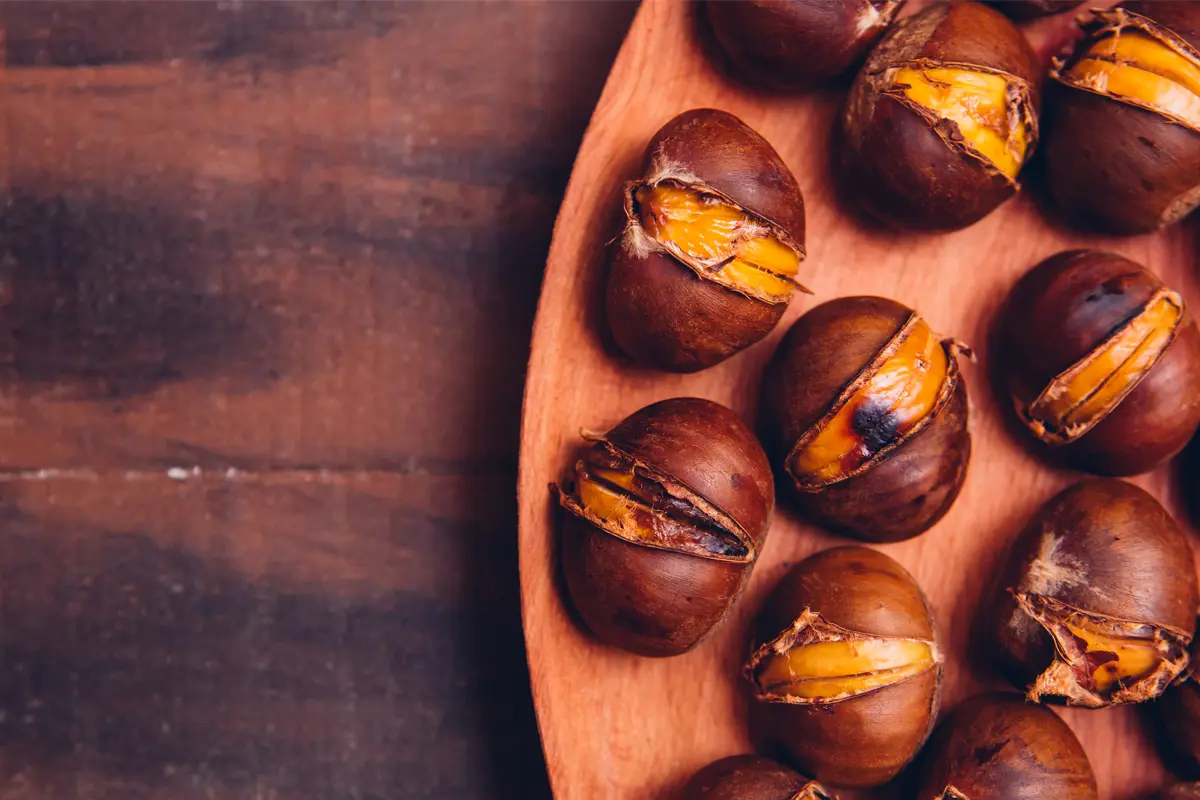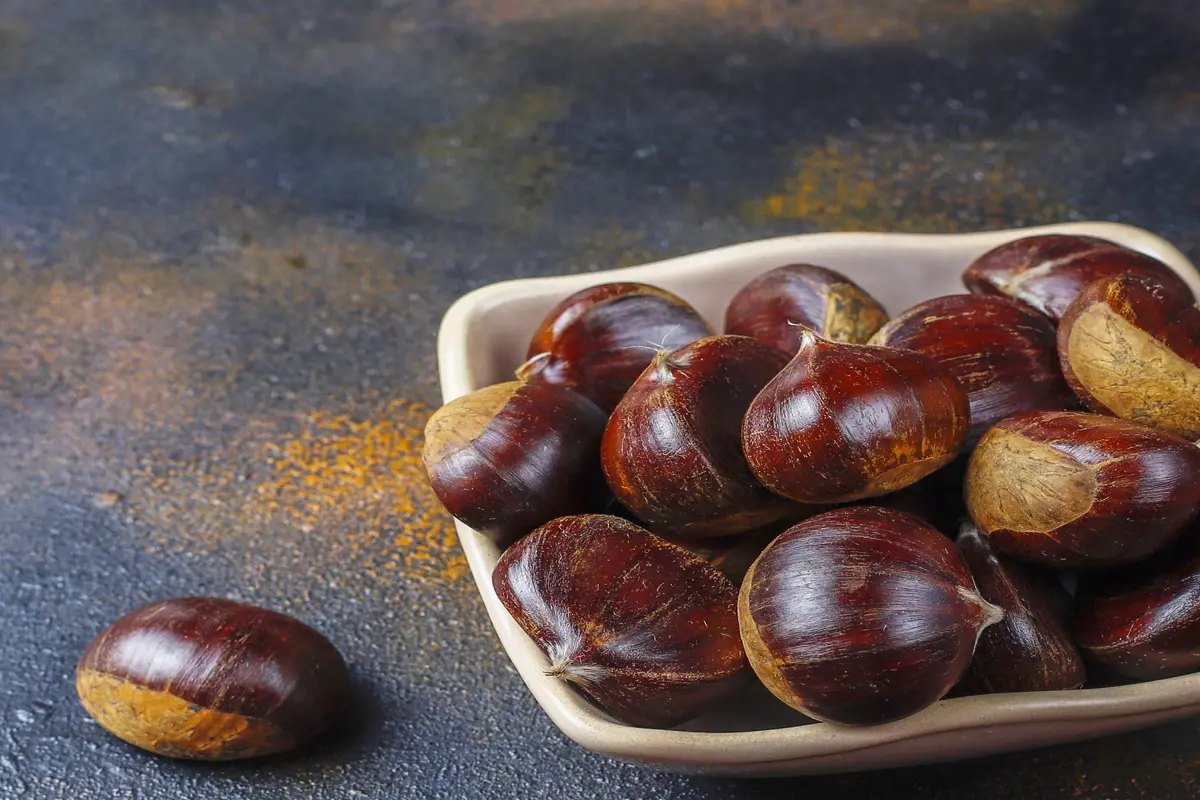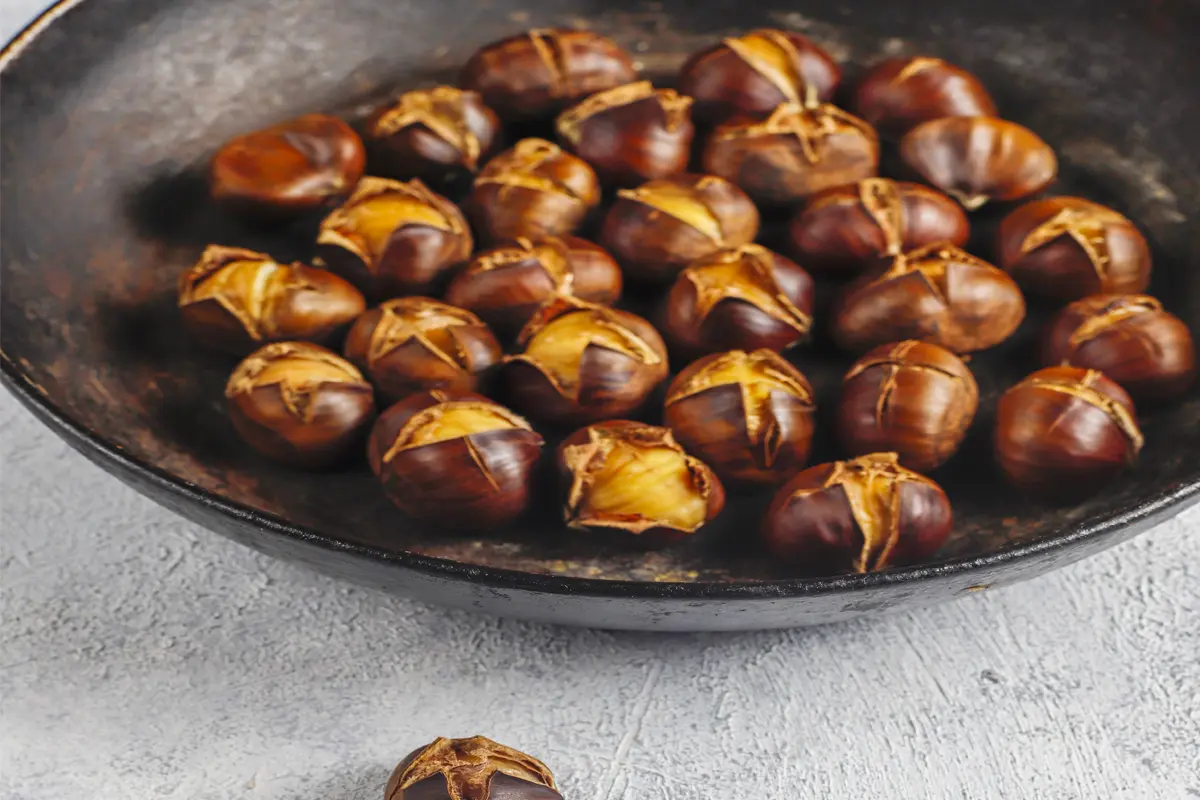Chestnuts are a versatile and nutrient-rich food with a history that spans thousands of years. From their role as a staple in ancient diets to becoming a holiday favorite in modern times, chestnuts hold a special place in many cultures around the world. In this article, we’ll explore everything you need to know about chestnuts, including their nutritional benefits, culinary uses, and some delicious recipes that you can try at home.
A Brief History of Chestnuts
People have cultivated and consumed chestnuts for over 2,000 years. The chestnut tree is native to regions in the Northern Hemisphere, particularly in Asia and Europe. In ancient times, chestnuts served as a vital food source, especially in mountainous regions where other crops were difficult to grow. The ancient Greeks and Romans praised chestnuts for their nutritional value and often referred to them as “bread trees” because of their role in sustaining communities.
In Europe, chestnuts became a staple food during the Middle Ages, often ground into flour and used to make bread and porridge. This tradition continues today in many Mediterranean countries, where chestnut flour remains a common ingredient in baking. In fact, chestnuts played a crucial role in sustaining populations during times of famine, offering a reliable source of nutrition when other crops failed.
The historical significance of chestnuts is also evident in their role in various cultural traditions. For instance, in Italy, locals celebrate the chestnut harvest with festivals like “La Sagra del Marrone,” where they enjoy roasted chestnuts, chestnut cakes, and other traditional dishes. In Japan, chestnuts symbolize autumn and often feature in seasonal dishes and sweets.
Nutritional Benefits of Chestnuts
Chestnuts have more complex carbohydrates than other nuts and less fat. They provide an excellent source of dietary fiber, vitamin C, and essential minerals like potassium, magnesium, and iron. Chestnuts are also gluten-free, making them a great alternative for people with gluten sensitivities.
Key Nutritional Highlights:
- Low in Fat: Chestnuts contain only 1-2 grams of fat per 100 grams, making them an ideal choice for those looking to reduce their fat intake while still enjoying a nutritious snack.
- Rich in Vitamin C: Chestnuts provide a significant amount of vitamin C, essential for immune health. This vitamin also plays a crucial role in collagen production, promoting healthy skin and wound healing.
- High in Fiber: With about 8 grams of dietary fiber per 100 grams, chestnuts support digestive health and help maintain stable blood sugar levels. The high fiber content also promotes satiety, making chestnuts a filling snack that can help with weight management.
- Gluten-Free: Chestnut flour offers a popular gluten-free option for baking. It can substitute for wheat flour in many recipes, adding a sweet, nutty flavor that complements both sweet and savory dishes.
In addition to these benefits, chestnuts provide a good source of antioxidants, which help protect the body from oxidative stress and inflammation. These antioxidants include vitamin C, gallic acid, and ellagic acid, all of which have been linked to various health benefits, such as reducing the risk of chronic diseases like heart disease and cancer.

Culinary Uses of Chestnuts
Chestnuts have a sweet, nutty flavor that makes them a versatile ingredient in both sweet and savory dishes. Here are some common ways to use chestnuts in your cooking:
1. Roasting Chestnuts
Roasting chestnuts is one of the most often used methods to appreciate them. Roasted chestnuts have a rich, sweet flavor and a soft texture that makes them a favorite during the holiday season. To roast chestnuts at home, score the shell with an “X” using a sharp knife, place them on a baking sheet, and roast at 400°F (200°C) for 20-25 minutes. The aroma of roasting chestnuts is reminiscent of holiday markets and cozy winter evenings, making this a cherished tradition for many families.
You can enjoy roasted chestnuts on their own or add them to dishes like salads, soups, and even desserts. For example, toss roasted chestnuts into a warm Caesar Pasta Salad for an added layer of flavor and texture. The combination of the nutty chestnuts with the creamy dressing and crisp greens creates a unique and satisfying dish.
2. Chestnut Stuffing
Chestnuts traditionally feature in holiday stuffing recipes. Their sweet and earthy flavor pairs perfectly with savory ingredients like sage, onions, and poultry. Add chopped chestnuts to your next stuffing recipe for a delicious twist on a classic dish. For instance, chestnut stuffing can elevate your Ultimate Rotisserie Chicken Recipe by adding a rich, nutty dimension that complements the juicy, flavorful chicken.
You can also use chestnut stuffing as a filling for vegetables like bell peppers or squash, creating a hearty and satisfying vegetarian dish. Additionally, serve chestnut stuffing as a side dish alongside roasted meats, enhancing the overall flavor profile of your meal.
3. Chestnut Puree
Chestnut puree offers a versatile ingredient for both sweet and savory dishes. To make chestnut puree, boil chestnuts until soft and blend them into a smooth paste. Use chestnut puree as a filling for pastries, add it to soups for extra creaminess, or spread it on toast with a drizzle of honey.
For a decadent dessert, consider using chestnut puree as a filling for cakes or tarts. For example, create a chestnut-flavored variation of the Blackberry Cheesecake by swirling chestnut puree into the cheesecake batter. The combination of the sweet, fruity blackberries and the rich, nutty chestnuts creates a unique and irresistible dessert.
4. Chestnut Flour
Chestnut flour provides a gluten-free alternative to wheat flour that adds a sweet, nutty flavor to baked goods. Use it to make bread, pancakes, and even pasta. For a unique dessert, try using chestnut flour in your next batch of cookies. Incorporate it into this Earl Grey Cookies Recipe for a distinctive flavor combination that pairs the floral notes of Earl Grey tea with the sweet, earthy taste of chestnuts.
Chestnut flour is also an excellent choice for making traditional Italian desserts like castagnaccio, a dense, rustic cake that highlights the natural sweetness of chestnuts. Typically, this cake is flavored with rosemary, pine nuts, and raisins, creating a dessert that is both simple and satisfying.
5. Chestnut Desserts
Chesnuts often appear in desserts like cakes, pastries, and puddings. A classic French dessert, Mont Blanc, features chestnut puree topped with whipped cream, resembling a snow-capped mountain. Add chestnuts to cheesecake recipes to provide a rich and creamy texture. Imagine a delicious twist on a Blackberry Cheesecake by incorporating chestnut puree into the filling.
Another delightful dessert option is chestnut mousse, a light and airy treat that you can serve on its own or layer in a trifle. The smooth, creamy texture of the mousse pairs beautifully with the subtle sweetness of the chestnuts, making it a perfect ending to a holiday meal.

Chestnut Recipes to Try at Home
Here are some unique and delicious chestnut recipes that you can try at home:
1. Chestnut Soup
This creamy chestnut soup is perfect for a cozy winter evening. The sweetness of the chestnuts pairs beautifully with savory herbs and a touch of cream.
Ingredients:
- 1 pound chestnuts, peeled and cooked
- 1 onion, chopped
- 2 cloves garlic, minced
- 4 cups vegetable or chicken broth
- 1 cup heavy cream
- Salt and pepper to taste
- Fresh thyme for garnish
Instructions:
- Sear the onion and garlic in a big pot until tender.
- Add the cooked chestnuts and broth, and bring to a boil.
- Reduce heat and simmer for 20 minutes.
- Blend the soup until smooth, then stir in the cream.
- Season with salt and pepper, and garnish with fresh thyme before serving.
Pair this chestnut soup with a crusty loaf of bread, such as Easy Homemade Sandwich Bread, to create a comforting and satisfying meal.
2. Chestnut and Mushroom Risotto
Chestnuts add a unique flavor and texture to this creamy risotto, making it a delightful dish for any occasion.
Ingredients:
- 1 cup arborio rice
- 1/2 pound mushrooms, sliced
- 1 cup cooked chestnuts, chopped
- 1 onion, chopped
- 2 cloves garlic, minced
- 4 cups vegetable broth
- 1/2 cup white wine
- 1/2 cup grated Parmesan cheese
- 2 tablespoons butter
- Salt and pepper to taste
Instructions:
- Sear the mushrooms, onion, and garlic in butter till tender.
- Add the rice and cook for 2 minutes, stirring constantly.
- Add the white wine and simmer till absorbed.
- One cup at a time, steadily add the broth, stirring constantly until the rice is done.
- Stir in the chestnuts and Parmesan cheese, and season with salt and pepper before serving.
Pair this risotto with a side of roasted vegetables or a fresh Caesar Pasta Salad, making it a versatile dish that you can enjoy year-round.
3. Chestnut Cake
This chestnut cake is a moist and flavorful dessert that works perfectly for any occasion.
Ingredients:
- 1 cup chestnut puree
- 1/2 cup sugar
- 1/2 cup butter, softened
- 3 eggs
- 1 cup flour
- 1 teaspoon baking powder
- 1/2 teaspoon vanilla extract
- Powdered sugar for dusting
Instructions:
- Preheat the oven to 350°F (175°C).
- Cream the butter and sugar together until light and fluffy.
- One at a time, add the eggs; mix thoroughly.
- Stir in the chestnut puree and vanilla extract.
- Fold the flour and baking powder together then into the batter.
- Spoon the batter into a prepared cake pan and bake until a toothpick put into the center comes out clean, 30 to 35 minutes.
- Allow the cake to cool, then dust with powdered sugar before serving.
For a festive touch, serve this chestnut cake with a dollop of whipped cream or a scoop of Oreo Ice Cream. The combination of the rich, nutty cake and the creamy, sweet ice cream is sure to impress your guests.
Chestnuts Around the World
Chestnuts are enjoyed in many different ways across the globe. In Italy, chestnut flour is used to make “castagnaccio,” a dense, rustic cake flavored with rosemary, pine nuts, and raisins. In Japan, chestnuts often feature in traditional sweets called “kuri-kinton,” made by mixing sweetened chestnut puree with mashed sweet potatoes.
In Korea, chestnuts appear in both savory and sweet dishes. “Bam-bokkeum,” a simple roasted chestnut dish, is a popular street food, while “Yaksik,” a sweet rice cake with chestnuts, jujubes, and pine nuts, is a traditional dessert served during special occasions.
In France, chestnuts are a key ingredient in festive dishes like “dinde aux marrons” (turkey with chestnuts), a popular holiday meal. This dish highlights the versatility of chestnuts, as they are used to stuff the turkey and are also served as a side dish. Similarly, in the United States, are a beloved ingredient in holiday recipes like chestnut stuffing, adding a touch of tradition and nostalgia to Thanksgiving and Christmas feasts.
The Environmental Impact of Chestnut Cultivation
Chestnut trees provide not only valuable nuts but also environmental benefits. These trees improve soil quality, prevent erosion, and provide a habitat for wildlife. In recent years, interest in chestnut agroforestry has grown as a sustainable farming practice.
Chestnut trees also play a role in climate change mitigation. As perennial crops, they require less intensive farming practices compared to annual crops like wheat or corn. This means they have a lower carbon footprint and can help sequester carbon in the soil.
Additionally, chestnut trees are resilient and can thrive in a variety of climates, making them an excellent crop for farmers looking to diversify their operations. Besides producing nuts, chestnut trees can also provide timber, adding another layer of economic value to their cultivation.
Conclusion: Embracing the Versatility of Chestnuts
Chestnuts are a delicious and nutritious food that can be enjoyed in a variety of ways. Whether you’re roasting them over an open fire, adding them to a hearty stuffing, or using chestnut flour in your baking, chestnuts offer endless possibilities for your diet.
By exploring the rich history and culinary potential of chestnuts, you’ll gain a new appreciation for this humble nut. So why not try one of the recipes mentioned in this article or experiment with your own chestnut creations? And don’t forget to check out related recipes like the Ultimate Rotisserie Chicken, Blackberry Cheesecake, and Earl Grey Cookies for more delicious inspiration.
In addition to their culinary uses, chestnuts contribute to a more resilient food system as a sustainable and environmentally friendly crop. By incorporating chestnuts into your diet, you’re not only enjoying a nutritious and flavorful food but also supporting sustainable agricultural practices that benefit both people and the planet.

